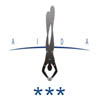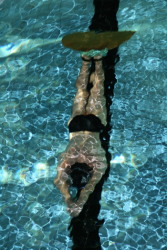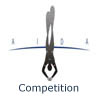|
home
|
APNOEVISION.CH
|
|
|
LAUFEND NEUE KURSE
International Association for the Development of Apnea AIDA **Freediver Course Outline
To enrol in the AIDA **Freediver course, an individual must:
COURSE PURPOSE
KNOWLEDGE DEVELOPMENT
The knowledge development will take place in a classroom-like
environment.
•
Introduction to AIDA as an organisation
CONFINED WATER DIVES
Static Apnea After this session the student freediver will be able to:
•
Demonstrate abdominal breathing and appropriate breathing techniques
in
•
Demonstrate appropriate recovery and breathing techniques at the end
of
•
Demonstrate how to train safely and effectively for static apnea in
a swimming • Perform a static breath hold of at least 2 minutes safely with a training buddy
•
Demonstrate the appropriate rescue technique for a static apnea
buddy Dynamic Apnea
This session should be conducted in a swimming pool or similar
confined water. After this session the student freediver will be able to: • Demonstrate how to prepare and don equipment for pool training
•
Demonstrate appropriate breathing techniques in preparation for a
breath
•
Demonstrate appropriate recovery and breathing techniques at the end
of
•
Demonstrate appropriate bi-finning style and technique for a breath
hold swimming
•
Demonstrate safety techniques for retaining an awareness of body
position within
•
Demonstrate how to train safely and effectively for dynamic apnea in
a swimming
•
Demonstrate appropriate rescue procedures for a freediver attempting
dynamic OPEN WATER DIVE SESSIONS
These dives should be conducted in open water with a fixed line to
be used as a point of reference by the student freediver. This line
should be sufficiently buoyed and weighted so that the student
freediver could use it to pull either up or down if necessary. The
line is recommended to be at least 8mm in diameter. The studetn
should use bi-fins for all the dives (except if they have head down
equalizing problems and are doing head-up pull-downs). When the
training takes place in water with less than 10m visibility, or in
water deeper than the depth at which the bottom plate is positioned,
a lanyard should be used for all dives except those where the
student is acting as a safety freediver. These dive sessions may be
conducted on one day however students are required to exit the water
between the dives and should be given adequate time for debriefing,
rest and relaxation and briefing for the second session. Open Water Dive Session One In open water, the maximum depth of the freedives should be fixed by the instructor based on the students’ ability and limited to not more than 12m, either by choosing a site of this depth or by placing a bottom plate on the line at a maximum of 12m. After this open water session, the student freediver will be able to:
•
Prepare and don equipment for open water freedive training. The
student will be
•
Demonstrate an awareness of buddy procedures and safety requirements
of
•
Demonstrate appropriate weighting for freediving. Students should be
weight so
•
Beginning with pull-downs – descend slowly along the line achieving
comfortable • Train for effective duckdives
•
Train for vertical swimming with bi-fins along the line with a
streamlined body • Demonstrate appropriate breathing during recovery from a freedive
If a student cannot equalise head down, they can complete everything
in the course except the 16m CWT dive. The student should be given a
completion form for the AIDA **Freediver course and instructions of
how they can work on their head down equalisation regularly on land
and in the pool, so that eventually they can complete the course.
These students will keep training with pull-downs, working on
equalisation throughout the whole course, and on horizontal swimming
to practice streamlining and efficient finning technique. Open Water Dive Session Two In open water, the maximum depth of the freedives should be limited to 16m, either by choosing a site of this depth or by placing a bottom plate on the line at a maximum of 16m. This session builds on all the skills of Open Water Dive Session 1, most of which will be repeated during the course of this session. After this open water session, the student freediver will be able to: • Keep training to inprove the duckdives
•
Keep train for vertical swimming with bi-fins along the line with a
streamlined • Perform controlled turns at the end of the descent • Supervise a buddy from the surface as they perform a freedive
•
Demonstrate rescue procedures for a freediver who arrives at the
surface Open Water Dive Session Three In open water, the maximum depth of the freedives should be limited to 20m, either by choosing a site of this depth or by placing a bottom plate on the line at a maximum of 20m. This session builds on all the skills of Open Water Dive Session 1 and 2, most of which will be repeated during the course of this session. After this open water session, the student freediver will be able to:
•
Perform an efficient, effective duck dive, remaining oriented to the
guide line
•
Supervise a buddy as they perform a freedive, meeting the buddy on
the ascent
•
Demonstrate rescue procedures for a freediver who experiences a
Black Out at EQUIPMENT Student Equipment – mask, bi-fins, snorkel, appropriate exposure protection, weightbelt, lanyard (ifappropriate) Instructor Equipment – mask, bi-fins, snorkel, appropriate exposure protection, weightbelt, stop watch, depth gauge, first aid kit, oxygen administration kit (in countries where this is permitted or required by local law) guideline with bottom plate, lanyard and floatation device (if appropriate)
Optional Equipment –lights,
underwater video camera INSTRUCTOR SUPERVISION
The AIDA **Freediver course may be conducted by an Active AIDA
Instructor with current CPR and First Aid training (completed within
the last two years). The instructor should carry liability insurance
for teaching freediving. The maximum student diver-to-instructor
ratio for open water training dives is four students per instructor
(4:1). This may rise to six students per instructor (6:1) when the
instructor is assisted by another freediver qualified to at least
AIDA **** level. The maximum student diver-to-instructor ratio in
confined water is eight students per instructor (8:1). With an AIDA
****Freediver acting as an Assistant, 4 additional students may be
added to this ratio to a maximum of 12 students. ADMINISTRATION AND PAPERWORK Before commencing any in-water training, each student freediver must complete the following documents, for students aged under 18 years, both must be co-signed by a parent or guardian:
•
AIDA Medical Statement – this must be completed in full with
students marking • AIDA Liability Release or local equivalent
The AIDA Instructor should hold these documents on file for a
minimum of seven years or longer if required by local legislation. CERTIFICATION PROCEDURES Freedivers who meet all the performance requirements outlined above may be certified as an AIDA **Freediver. Freedivers who meet all the performance requirements other than those listed under Open Water Dives may be certified as AIDA **Pool Freediver.
The certification request should mot be send later than 3 month from
the certification date. KEY STANDARDS
Prerequisite certifications: None
AIDA Freediver Kurse
AIDA Spezial Kurse
|
||



 AIDA *Freediver
AIDA *Freediver AIDA ***Freediver
AIDA ***Freediver AIDA ****Freediver
AIDA ****Freediver


 AIDA Competiton
Freediver
AIDA Competiton
Freediver

.jpg) Entspannungs-/
Mentaltraining
Entspannungs-/
Mentaltraining